In spite of all the experience we have, or perhaps because of that, we seem to be destined to repeat some of the same problems again and again when we are cruising.
Back in 2014, during our second winter in the Bahamas, we became solidly stuck on the bottom when we tried to pull up our anchor. I pulled and pulled and finally gave up on retrieving my anchor only to go swimming to pull it out from under the limestone ledge where it had become wedged. It looked terrible and ultimately, I had to toss it and get another anchor. This is what it looked like at the time when I finally got it aboard. Pretty mangled. Well, a few days ago when we tried to anchor in the harbor off of Fort de France to visit for Carnival, we were having a terrible time anchoring and after about 5 tries, accompanied by advice for perhaps a half dozen other cruisers, we finally were firmly hooked. However, in spite of our best efforts, we decided that we were just too close to another boat and decided to leave.
Well, a few days ago when we tried to anchor in the harbor off of Fort de France to visit for Carnival, we were having a terrible time anchoring and after about 5 tries, accompanied by advice for perhaps a half dozen other cruisers, we finally were firmly hooked. However, in spite of our best efforts, we decided that we were just too close to another boat and decided to leave.
Unfortunately, as we began to retrieve our anchor, we realized that it wasn’t coming up. I pulled and pulled on it and we moved the boat to different angles with no results. The way that the boat came up short when the chain went taught, was really alarming.
However, finally we were able to get it back except that they shank was badly mangled, bent perhaps 30 degrees. Deja vous all over again. Only, this time our anchor is a stainless steel anchor that would cost about $2,500 to replace, a lot more than the one we damaged years ago.
Anyway, I shipped tthe anchor and we hightailed out of Fort de France and headed across the bay to lick our wounds. I am hopeful that when we are in La Marin next week that there will be a shop that can address this and bend the shank back into place. Fingers crossed.
The good news is that we were able to pull it up finally, if damaged as it was way too deep for me to dive on it and to get a diver on short notice wasn’t going to work out particularly well, I expect.
However, we moved across the harbor to a little village and took a ferry over to Ft de France yesterday to enjoy some of the festivities. I understand from some friends that are still over there, that it’s been crazy with boat after boat coming in and trying to anchor in impossibly tight conditions. Glad we moved.
This season has been rainier than normal and two days ago it rained just about all day. At home when the weather calls for say, 30% chance of showers, this generally means that perhaps a third of the area will see rain. Here it seems to mean that it will rain a third of the time. And that day, it was more like rain hard for 10 minutes, sunny for 20 and rain again. It’s hard to plan activities outdoors in those conditions.
Rain or shine, the view off of our stern, and it’s fairly calm here, is quite beautiful. A golf course. Notice the perfectly manicured mangrove hedge at the water. They even cut little pass-throughs to allow them to get to the waterside to trim that too. 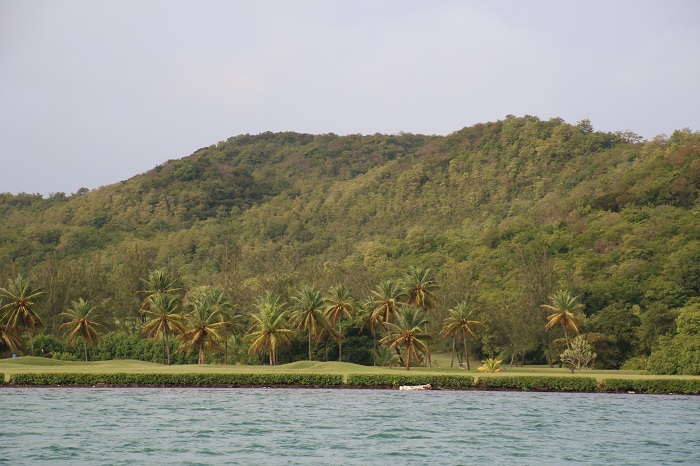 The town nearby is quaint if a bit deserted. We went ashore to have lunch and look around a bit. About the only action in town was a farmer’s market but there were not many places to eat.
The town nearby is quaint if a bit deserted. We went ashore to have lunch and look around a bit. About the only action in town was a farmer’s market but there were not many places to eat.
 A very pretty church, something that just about every village has here.
A very pretty church, something that just about every village has here. And some very nice French Colonial architecture.
And some very nice French Colonial architecture.  Before we headed here we were in St Pierre, one of our favorite spots where we planned to spend a few days. Unfortunately, after the first night the anchorage became very rolly (what’s new?) and we all decided to head to Fort de France.
Before we headed here we were in St Pierre, one of our favorite spots where we planned to spend a few days. Unfortunately, after the first night the anchorage became very rolly (what’s new?) and we all decided to head to Fort de France.
Before we left, we did visit the Depaz distillery. This link is interesting and gives a good feel for what it’s about.
A grand entrance to the estate.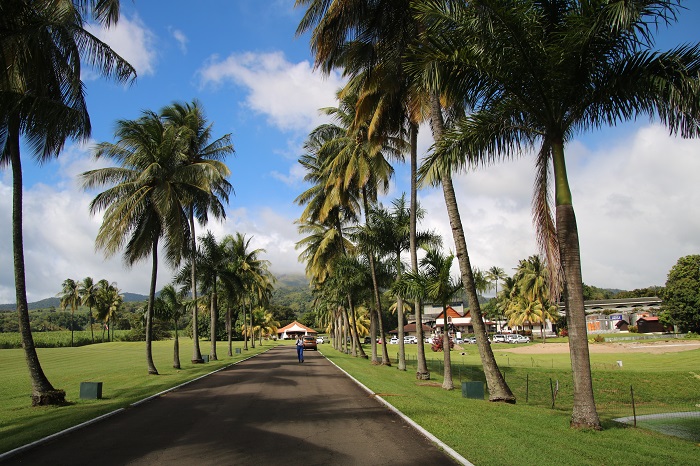 They have a very nice tasting room that has finally reopened after being closed for a few years because of the pandemic.
They have a very nice tasting room that has finally reopened after being closed for a few years because of the pandemic. 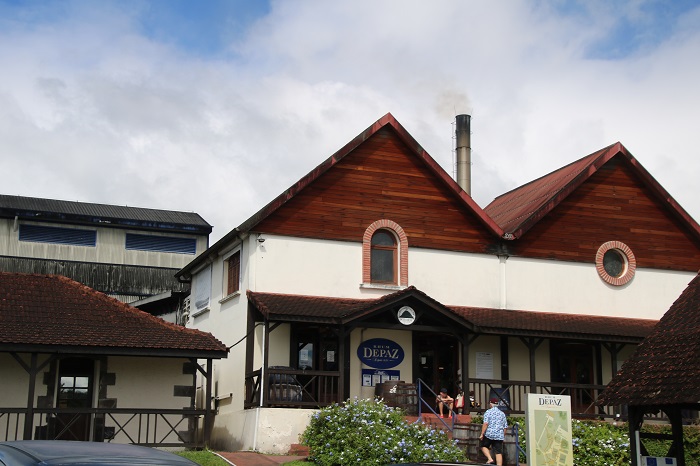 When our friends Peter and Jane join us in March, I expect that we will be visiting it again as it’s one of my favorite and not far from the harbor. If you are curious about this place and the history of the island and sugar, take a look at this post I did a few years ago. I also talked a book, The Sugar Barrons, a very interesting book that’s well worth reading.
When our friends Peter and Jane join us in March, I expect that we will be visiting it again as it’s one of my favorite and not far from the harbor. If you are curious about this place and the history of the island and sugar, take a look at this post I did a few years ago. I also talked a book, The Sugar Barrons, a very interesting book that’s well worth reading.
San Pierre also has a very interesting history as the once capital of Martinique and the “Paris of the Caribbean” until it was leveled by the explosion of Mt Pele that overlooks the city in 1902. The explosion killed everyone in the vicinity as super-heated gas and volcanic ash blanketed the city, with some 30,000 dead in moments. You can still see much of the ruins that have been preserved near the waterfront.  Nowadays, the capital is Fort de France to the south.
Nowadays, the capital is Fort de France to the south.
I did a more detailed post last season when we visited St Pierre including a discussion about the explosion that destroyed the city.
There’s been plenty going on for the last few weeks but one constant has been rolly anchorages with the exception of where we are now and Dominica.
That harbor in Dominica is huge but more of a roadstead than harbor as it’s completely open to the west. Because of the large harbor and the popularity of Dominca with cruisers who enjoy hiking on the island, we decided to hold a special rendezvous with the Salty Dawgs and more than 25 boats showing up. It was nearly a week of fun, barbecue parties, tours and hiking.
Dominica is one of the poorest countries in the Caribbean and the locals really appreciate it when we arrive en-mass.
Along with a number of rum punch soaked barbecues, a group of of us spent a day planting seedling palm trees down the side of a road, about 200 of them at 20′ intervals. They took us to a local nursery to pick them up. 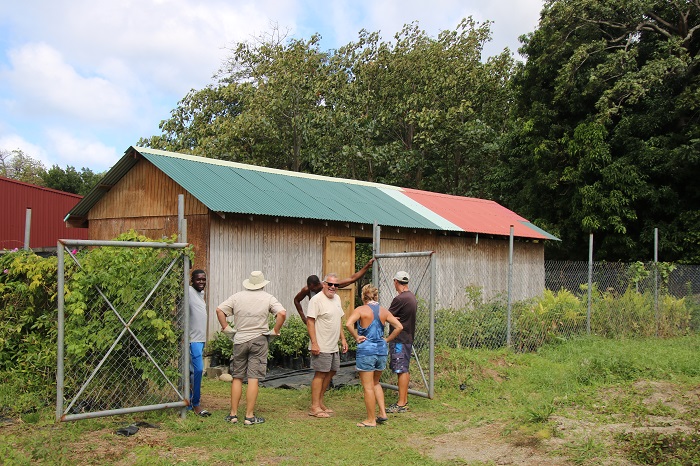 It seemed like there were as many of us as plants to load so we formed a bucket brigade to get them on the truck.
It seemed like there were as many of us as plants to load so we formed a bucket brigade to get them on the truck.  Off we went. It was hot work but nice to help out.
Off we went. It was hot work but nice to help out.  On another day, three couples hired a driver to take us around the island. We visited a small local chocolate factory. These are the chocolate pods all piled up on the ground. Each pod contains many coco beans, each about the size of a large almond.
On another day, three couples hired a driver to take us around the island. We visited a small local chocolate factory. These are the chocolate pods all piled up on the ground. Each pod contains many coco beans, each about the size of a large almond.  The pod, when mature, are about 8″ long. It’s amazing how tiny these pods begin, sprouting along a branch. They are solo and only about 1/8″ long.
The pod, when mature, are about 8″ long. It’s amazing how tiny these pods begin, sprouting along a branch. They are solo and only about 1/8″ long.  Then they get big but aren’t harvested until they are ripe and yellow.
Then they get big but aren’t harvested until they are ripe and yellow.  After the pods are opened and seeds removed, they are put in a box and covered with banana leaves to ferment for almost a week.
After the pods are opened and seeds removed, they are put in a box and covered with banana leaves to ferment for almost a week. 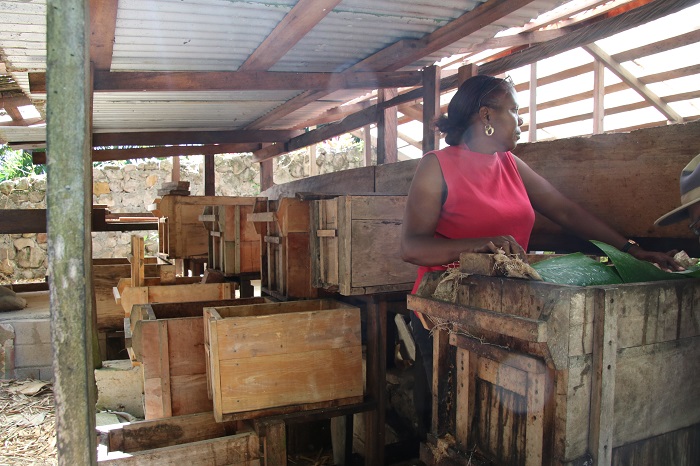 Then they are cleaned and spread to dry under cover.
Then they are cleaned and spread to dry under cover. There are a bunch of other steps that include roasting in special ovens.
There are a bunch of other steps that include roasting in special ovens.  Then they are crushed and the “hull” is separated from the good parts using air that blows off the hull and lets the heavier parts drop into a hopper.
Then they are crushed and the “hull” is separated from the good parts using air that blows off the hull and lets the heavier parts drop into a hopper.  Ultimately they are ground into a smooth paste over a period of days before being melted and poured into molds.
Ultimately they are ground into a smooth paste over a period of days before being melted and poured into molds.  As you can imagine, this whole process smells fabulous so who can leave without buying some to take home?
As you can imagine, this whole process smells fabulous so who can leave without buying some to take home?
Nearby, also on the estate, were many beautiful flowers. This one looked a lot like a version of milkweed.  And, a more native version of poinsettia, n0t the highly hybridized versions that we see in the US.
And, a more native version of poinsettia, n0t the highly hybridized versions that we see in the US.  And no tropical garden is complete without orchids. This one looks like a phalaenopsis but I believe is a native orchid, perhaps oncidium.
And no tropical garden is complete without orchids. This one looks like a phalaenopsis but I believe is a native orchid, perhaps oncidium.  Very showy flowers on a large bush.
Very showy flowers on a large bush. 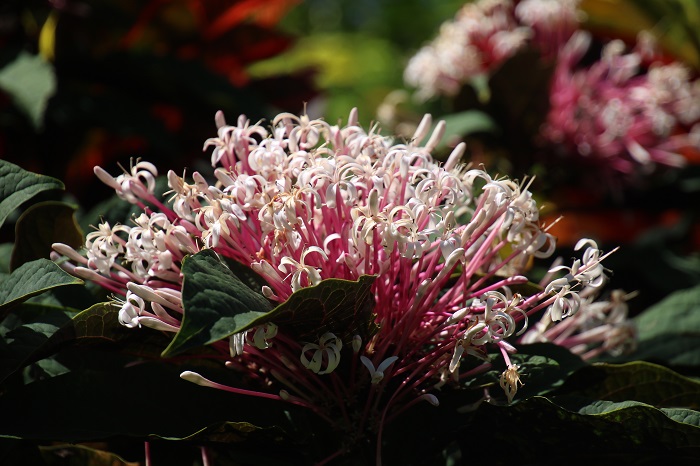 So often looking like house plants that escaped.
So often looking like house plants that escaped.  And breadfruit. It is said that all the breadfruit trees in the new world are descended from those brought on the Bounty by Captain Cook.
And breadfruit. It is said that all the breadfruit trees in the new world are descended from those brought on the Bounty by Captain Cook.  The rest of the day was spent driving around with beautiful vistas around every bend in the road.
The rest of the day was spent driving around with beautiful vistas around every bend in the road.  This gorge looked a bit intimidating with the gnarly roots of the trees snaking everywhere.
This gorge looked a bit intimidating with the gnarly roots of the trees snaking everywhere.  A must-stop place in Dominica is known as Red Rock. It’s an exposed outcropping of red sandstone, weathered over the years into something that looks more like dunes than rocks.
A must-stop place in Dominica is known as Red Rock. It’s an exposed outcropping of red sandstone, weathered over the years into something that looks more like dunes than rocks. 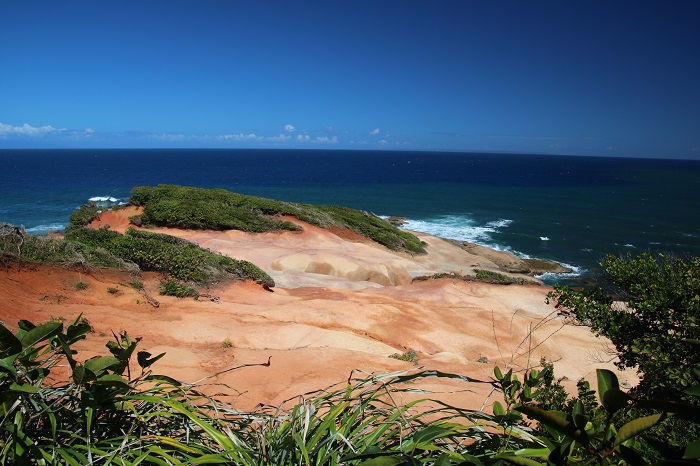 A pretty amazing place.
A pretty amazing place.  Just to prove were there.
Just to prove were there.  We visited a place where the mostly dormant volcano vents gasses through the ground. The place, nestled in the jungle, stands out as a small area with nothing growing and a very strong smell of Sulphur. Leading down into the crater was lush with tree ferns, some 30′ tall all around.
We visited a place where the mostly dormant volcano vents gasses through the ground. The place, nestled in the jungle, stands out as a small area with nothing growing and a very strong smell of Sulphur. Leading down into the crater was lush with tree ferns, some 30′ tall all around.  They are just beautiful and only grow above a certain altitude.
They are just beautiful and only grow above a certain altitude. 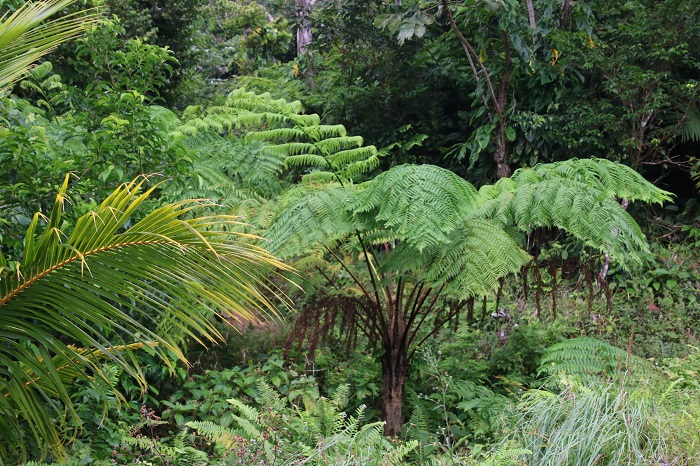 The hills were carpeted with them.
The hills were carpeted with them. Well, I guess I’ll leave it there for now and follow up with a post soon about Carnival but there is just so much that I can cram into a single post.
Well, I guess I’ll leave it there for now and follow up with a post soon about Carnival but there is just so much that I can cram into a single post.
All and all, it’s been interesting if a bit challenging with strong winds, unsettled anchorages and, most fun of all, a damaged anchor. Hope that gets fixed soon. At least it’s still usable if a bit gnarly to look at.
They say that cruising is generally boat repair in exotic places. Yes, into every life a little rain must fall. For me, I prefer the wet kind.
Sometimes it’s the other kind and I have a bent anchor to prove it.
